Panama City and
The Canal
PANAMA CITY
We all were ecstatic to reach Panama City. We were
slapping the high fives. As we entered it was another world, filled with these
huge monster dinosaur like freighters. They were anchored out in the
surrounding waters waiting for the cue to get into the canal. Some were being
fueled by support ships, and some had crews swimming in the waters off the
deck. They were massive monsters. We slowly navigated our way in and were
struck by the immense cityscape that lay before us. After miles and weeks of
small villages without roads or connections to civilization, this was a surreal
oasis of civilization.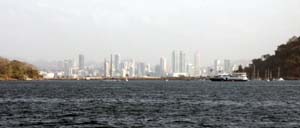
We passed the causeway that linked the small islands
outside the city, all built from the earth and rock removed for the construction
of the Panama Canal.
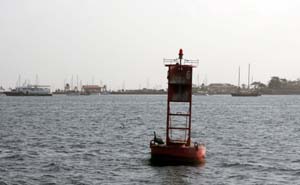 We passed the Flamingo Yacht Club which was full. We
headed into the canal navigation markers to pick up a mooring at the Balboa
Yacht Club. This Club according to Dave was more rustic and you were not
allowed to bring your dinghy ashore but were captive to the club’s launches to
pick up you and deliver you back to your boat. We were greeted by one of the
launch drivers, who helped lift the mooring lines up to us so we could secure
them to our bow. We were on the outer edge of the moorings right next to one of
the navigation markers. The freighters and yachts would be passing right by us
all day and all night long entering and leaving their passage through the
canal. We worried about how rolly this mooring would be but had no choice. We passed the Flamingo Yacht Club which was full. We
headed into the canal navigation markers to pick up a mooring at the Balboa
Yacht Club. This Club according to Dave was more rustic and you were not
allowed to bring your dinghy ashore but were captive to the club’s launches to
pick up you and deliver you back to your boat. We were greeted by one of the
launch drivers, who helped lift the mooring lines up to us so we could secure
them to our bow. We were on the outer edge of the moorings right next to one of
the navigation markers. The freighters and yachts would be passing right by us
all day and all night long entering and leaving their passage through the
canal. We worried about how rolly this mooring would be but had no choice.
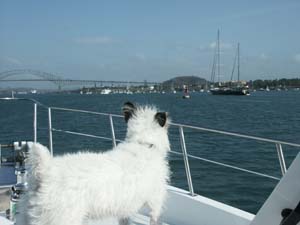 Again the paperwork “cha cha” began. First we were boarded
by the canal inspector, a Mr. Spencer, who was here to obtain info statistics
about the and to literally measure with a tape measure, the Knotty Dog for the
passage. He asked all sorts of detailed questions about the engine, fuel
quantity, size, etc. etc. Our agent Tina was our contact and she arrived
shortly. Again the paperwork “cha cha” began. First we were boarded
by the canal inspector, a Mr. Spencer, who was here to obtain info statistics
about the and to literally measure with a tape measure, the Knotty Dog for the
passage. He asked all sorts of detailed questions about the engine, fuel
quantity, size, etc. etc. Our agent Tina was our contact and she arrived
shortly.
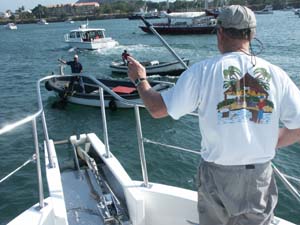 She was responsible to make all our arrangements for the canal passage
and customs clearing. She had been recommended by “Uno Mas”, another Nordhavn,
who was ahead of us. They warned us that she a “talkative” Panamanian. I liked
her, she was small but spunky and pushy, and she ordered these guys around like
you wouldn’t believe. She gave us a cell phone that we could use to contact
her. We told to buy some minutes on it and that’s how we would be in
communication. She also gave us a brand new Lonely Planet Travel Guide on
Panama and said we had to return it when we left. She was a kick and
efficient. She was responsible to make all our arrangements for the canal passage
and customs clearing. She had been recommended by “Uno Mas”, another Nordhavn,
who was ahead of us. They warned us that she a “talkative” Panamanian. I liked
her, she was small but spunky and pushy, and she ordered these guys around like
you wouldn’t believe. She gave us a cell phone that we could use to contact
her. We told to buy some minutes on it and that’s how we would be in
communication. She also gave us a brand new Lonely Planet Travel Guide on
Panama and said we had to return it when we left. She was a kick and
efficient.
We all, as a group, decided that we’d like to leave by
Tuesday to do the canal transit if it worked. That would give us some time to
see the city and provision. Once that was decided the ball was rolling in
Tina’s court.
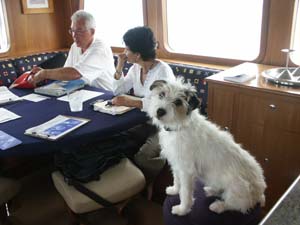 Next came the Canal Clearing agent or customs agent. He
asked about our meat. He wanted to know if it was from Washington because of
the mad cow disease. We said it all came from San Diego, so no problems. Then
came the Panama City Clearing agent with his college student trainee. Tina
blasted the agent for bringing an extra person on board. All went very
smoothly. Tina took our passports and said she would return tomorrow with our
passports and the lines that we were going to rent for the passage. Next came the Canal Clearing agent or customs agent. He
asked about our meat. He wanted to know if it was from Washington because of
the mad cow disease. We said it all came from San Diego, so no problems. Then
came the Panama City Clearing agent with his college student trainee. Tina
blasted the agent for bringing an extra person on board. All went very
smoothly. Tina took our passports and said she would return tomorrow with our
passports and the lines that we were going to rent for the passage.
By now it was late in the afternoon and Dave and I stayed
aboard while Larry went to shore to do some final paperwork with Tina.
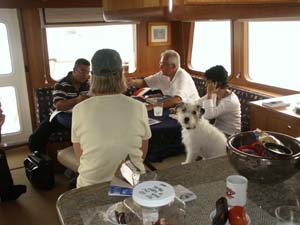 Richard
and Margie were in such a rush to get off the boat they almost didn’t wait to
get cleared by customs. I had to keep telling Richard he couldn’t leave until
all the agents cleared us. He was crazed to get off the boat. I guess he was
anxious to get his glasses repaired as the lenses weren’t in securely as he had
a fall on the boat and knocked his head and broke his glasses again. Richard
and Margie were in such a rush to get off the boat they almost didn’t wait to
get cleared by customs. I had to keep telling Richard he couldn’t leave until
all the agents cleared us. He was crazed to get off the boat. I guess he was
anxious to get his glasses repaired as the lenses weren’t in securely as he had
a fall on the boat and knocked his head and broke his glasses again. 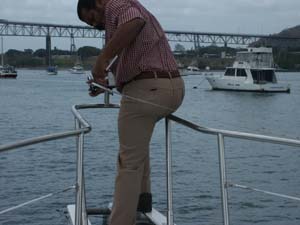 Dave
rinsed and washed the outside the best he could with our fresh water and I
vacuumed and cleaned the boat inside. When finished cleaning Richard and Margie
came back, his glasses fixed and telling us about going to the Artisan Stores
and Internet café, etc. Dave
rinsed and washed the outside the best he could with our fresh water and I
vacuumed and cleaned the boat inside. When finished cleaning Richard and Margie
came back, his glasses fixed and telling us about going to the Artisan Stores
and Internet café, etc.
That evening, we all took a cab to the Flamenco Marina
where there was a mini mall and several restaurants. We had some cocktails and
fish dinners and watched the sun go down over the skyline of Panama City. As we
were getting ready to leave, Richard went to the bathroom and got lost on his
way back. Margie said for us to go on that he gets lost all the time. We
didn’t want to leave here alone so we insisted on waiting.
BALBOA YACHT CLUB
The Balboa Yacht Club is pretty rustic.
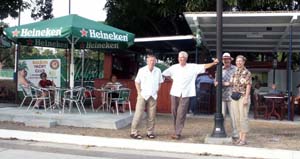 It consists of a
long old pier with a greasy fuel dock at the end. At the top of the pier is a
make shift open area bar which is pretty much just a concrete slab with plastic
chairs and tables, covered with a tin awning. There’s a make shift bar counter
and the whole operation works out of ice chests and a small portable trailer
much like what you would find at a carnival or fair. Yachters of all
nationalities hang out there drinking Panamanian beer and talking about where
they’ve been and giving pointers to other cruisers headed in the direction that
they just came from. The surrounding area is a strange place, left over from
the US occupation. Streets with white curbs and abandoned buildings and empty
fields. Nearby is a small 6-story hotel, Courtyard Inn or something like that,
with a TGIF restaurant and bar out front on the waterfront. It consists of a
long old pier with a greasy fuel dock at the end. At the top of the pier is a
make shift open area bar which is pretty much just a concrete slab with plastic
chairs and tables, covered with a tin awning. There’s a make shift bar counter
and the whole operation works out of ice chests and a small portable trailer
much like what you would find at a carnival or fair. Yachters of all
nationalities hang out there drinking Panamanian beer and talking about where
they’ve been and giving pointers to other cruisers headed in the direction that
they just came from. The surrounding area is a strange place, left over from
the US occupation. Streets with white curbs and abandoned buildings and empty
fields. Nearby is a small 6-story hotel, Courtyard Inn or something like that,
with a TGIF restaurant and bar out front on the waterfront.
This is where the cabs line up to take the
yachters into
the city for all their errands. The taxi drivers usually get hired for a full
day to take the yachters around on their errands to the grocery stores,
sightseeing, hardware stores and marine part stores. They will wait for you
while you do your shopping or sightseeing. 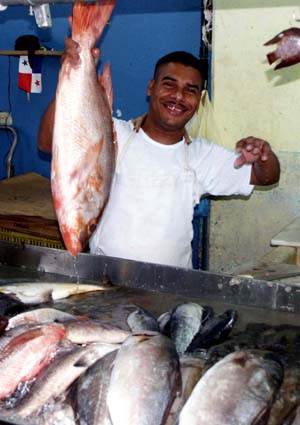 They charge about $10 American per
hour. All the taxis are all smaller than you would like with all that you need
to carry and few have AC. The heat is unbearable and it’s not a pleasant
experience to get out in it but you get by. About ½ mile away are the leftovers
of the army base where we can get to the internet and it has a large tin covered
structure with various Panamanian artisans, (mostly Kuna Indian’s) show their
wares. They charge about $10 American per
hour. All the taxis are all smaller than you would like with all that you need
to carry and few have AC. The heat is unbearable and it’s not a pleasant
experience to get out in it but you get by. About ½ mile away are the leftovers
of the army base where we can get to the internet and it has a large tin covered
structure with various Panamanian artisans, (mostly Kuna Indian’s) show their
wares.
Dave, Larry and I head for the old town called CASCO VIEJO
to do some sightseeing. Margie and Richard want to do their own thing. We were
warned by Tina that when going to the city to always keep the taxi driver with
you, and have him wait, as many areas in the city are unsafe. The books say not
to draw attention to yourself with fancy jewelry and watches or clothing. We
could understand this as we drove into the city and saw the many tenements and
horrible living conditions that the masses were living in. I have never quite
seen anything like it. It was shocking how many people were crowded into these
dirty buildings.
FISH MART
We had the cab driver drop us at the fish market. It was
an amazing fun sight. It was a large warehouse with rows of tables and plastic
bins filled with all kinds of fish and shellfish. The workers were busy
weighing and cutting the fish. They loved having their pictures taken and would
proudly hold up their prize fish for the day with a huge smile. It was a
colorful place.
We then walked the waterfront towards the old city and
passed some run down wharfs with hundreds of pelicans. The shore was filled
with trash and the buildings were grey and black and falling apart. It looked
like the end of the world. In the distance across the water we could see the
tall skyscrapers of the new city. It was a sharp contrast to the poverty of the
area we were walking through.
As we walked further down, we came to another district
which I can only describe has make shift junk shops but probably served as the
local hardware stores for the poor living in the squallier nearby. They had a
little bit of everything. One vendor had a collection of hubcaps; another old
used wires of all sorts, old boots, just junk.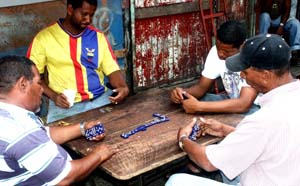 The vendor would be sitting an
old ragged upholstered chair that looked like it was falling apart. Another
would be sleeping on a pile of dirty cardboard piled up to make a bed. The
streets were filled with men. Most of the men looked like they were
unemployed. I felt very uncomfortable for my safety in this area though it was
fascinating. We gringos were out of place. The vendor would be sitting an
old ragged upholstered chair that looked like it was falling apart. Another
would be sleeping on a pile of dirty cardboard piled up to make a bed. The
streets were filled with men. Most of the men looked like they were
unemployed. I felt very uncomfortable for my safety in this area though it was
fascinating. We gringos were out of place.
We continued along the waterfront and passed the meat
market. It was set up pretty much the same as the fish market although the
workers were not friendly or anxious to have their pictures taken. We passed
rows of women with card tables and folding chairs selling lottery tickets that
we lined up in neat rows across their tables. We passed the other markets that
were small stalls crowded together with dark narrow walkways that sold just
about anything.
It was an amazing site but I was glad to be getting nearer
to the old city. I could see the pleasant colonial architecture up ahead and
was anxious to leave this part of the city though fascinating I did not feel
safe. As we walked up the hill to the old city we could see the modern
skyscrapers in the distances and the poverty and decadence of the poor section
in the foreground.
CASCO VIEJO
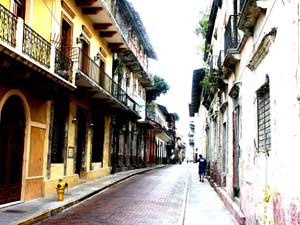 The old city is immediately charming in that the buildings
exude history and ambience from a time long past. Most of the buildings are run
down and boarded up but many though are under renovation and some are completely
restored and when they are restored they are magnificent. We walked along the
waterfront of the old city and came to a heavily guarded area, which was the
President’s Palace, a huge white colonial building. Young smart looking armed
guards in dark khaki uniforms with red berets an polished black boots guarded
the access to the palace grounds. I asked one of the guards if I could take a
picture, which he posed very proudly. The old city is immediately charming in that the buildings
exude history and ambience from a time long past. Most of the buildings are run
down and boarded up but many though are under renovation and some are completely
restored and when they are restored they are magnificent. We walked along the
waterfront of the old city and came to a heavily guarded area, which was the
President’s Palace, a huge white colonial building. Young smart looking armed
guards in dark khaki uniforms with red berets an polished black boots guarded
the access to the palace grounds. I asked one of the guards if I could take a
picture, which he posed very proudly. 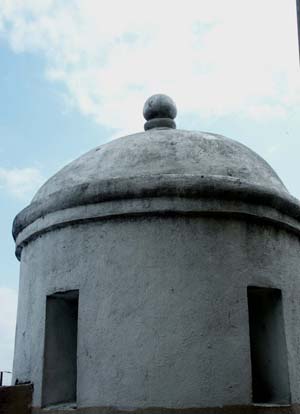 He then invited us to come into the gated
area to see the front entrance to the palace that overlooked the waterfront. He
also gave us a small brochure on the history and present function of the
building. He then invited us to come into the gated
area to see the front entrance to the palace that overlooked the waterfront. He
also gave us a small brochure on the history and present function of the
building.
The grand old building was well taken care of and the front
entrance was graced with steps leading up to three arches, all protected by iron
gates with another armed guard standing at station with his legs spread apart
and arms tightly behind him in an “at ease” position. I then noticed the grey
herons behind the gates on the front portico and in the inner courtyard were
some more. They were huge and looked very elegant like they had grey dinner
jackets with crisp white colors and black ties, the illusion created by their
beautiful feather formation. They were very spry and flighty and were comical
as they hid behind the large white
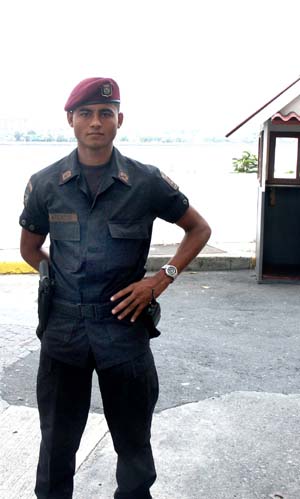 pillars of the entry arches. They were very
shy as you approached them and then if you walked away they would come out in
the open and sort of chase you to tease you back to them. They must have been
about 5 feet tall. The guard would crack a smile as I played with them. The
president of Panama resides within the building much like the white house in
Washington. Many functions and state affairs occur there. pillars of the entry arches. They were very
shy as you approached them and then if you walked away they would come out in
the open and sort of chase you to tease you back to them. They must have been
about 5 feet tall. The guard would crack a smile as I played with them. The
president of Panama resides within the building much like the white house in
Washington. Many functions and state affairs occur there.
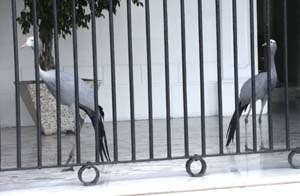
We walked along further down the waterfront and turned a
corner, admiring the colonial architecture and the restoration that was going
on. We came to the Simon Bolivar Square, which was left over from the canal
days when the French were in charge of the construction of the canal. The
bronze sculpture in the center was typically French flamboyant and large ficus
trees filled each corner of the plaza perfectly trimmed to gum ball shapes.
It was back dropped by a beautiful white cathedral small in stature but very
colonial in style. As we walked on the cobble stone streets further into the
center of the old city we remarked that the buildings had a New Orleans feel
with many balconies, with ornate ironwo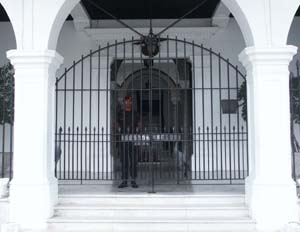 rk and large colorful plantation shutters
and ornate overhanging eaves with detailed, ornately designed corbels. Each
building was a different color and accented by painted trims. Some were
occupied and filled with colorful laundry hanging out to dry. We came to the
main plaza, small in size but large in style. It was a place of many historic
happenings during the early years. The centerpiece of the plaza was a large
gazebo, which I’m sure, staged many important historical events. The gazebo was
flanked on four sides by large trees and grassed areas that were cordoned off by
ornate iron fences. rk and large colorful plantation shutters
and ornate overhanging eaves with detailed, ornately designed corbels. Each
building was a different color and accented by painted trims. Some were
occupied and filled with colorful laundry hanging out to dry. We came to the
main plaza, small in size but large in style. It was a place of many historic
happenings during the early years. The centerpiece of the plaza was a large
gazebo, which I’m sure, staged many important historical events. The gazebo was
flanked on four sides by large trees and grassed areas that were cordoned off by
ornate iron fences.
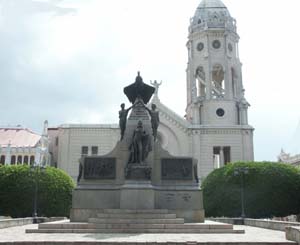 One side of the plaza had the huge old cathedral with two
white bell towers and the center was a brownish stone material with ornate
carvings. To the left on the other side of the park was the old hotel that many
important historical figures had stayed. We could picture the old days as the
horse drawn carriages would clamber down the streets and stop in front of the
hotels loading and unloading dignitaries that were involved in the most massive
building project the world had seen or dreamed about. One side of the plaza had the huge old cathedral with two
white bell towers and the center was a brownish stone material with ornate
carvings. To the left on the other side of the park was the old hotel that many
important historical figures had stayed. We could picture the old days as the
horse drawn carriages would clamber down the streets and stop in front of the
hotels loading and unloading dignitaries that were involved in the most massive
building project the world had seen or dreamed about.
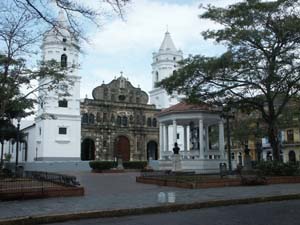
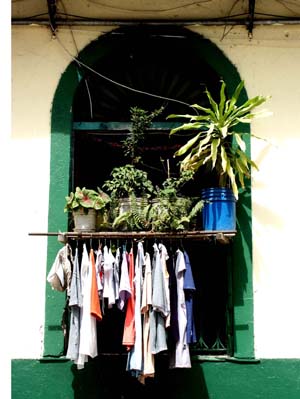
We continued on to the other side of the old town, which
faces the ocean on the other side; as the old town is build on a point. There
is a grand old walkway on the waterfront that curves around with a large
dramatic curving stairway that leads down to another plaza and cathedral. This
is also where the old dungeons were and are now occupied by a fine restaurant an
upscale art gallery.
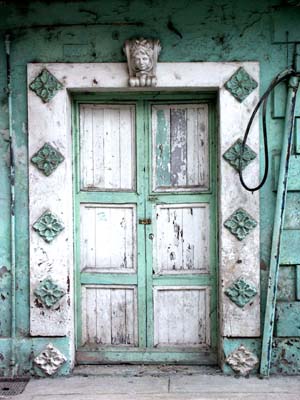
This area again had a flamboyant flair that only the
French can do. There was a display of many busts of famous Frenchmen of the
early 20th century. The site was also to honor the more than 20,000
workers that died from yellow fever, malaria and land cave-ins while making the
canal.
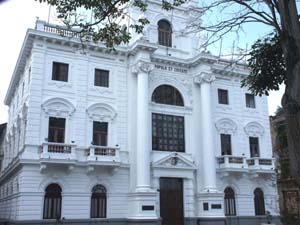
We stopped at the only sidewalk café we could find to get
some drinks and have lunch. There’s so much so see and enjoy here but the heat
was beyond bearable and zapped the energy right out of you. We had a nice lunch
and watched the world go by. Many Zuna Indians dressed in their full regalia
paraded by, looking out of place in this city, and workers busy running back and
forth with their old fashioned tools and wheel barrels, busily involved in the
renovation business of the old city. We had a nice lunch but when Larry gave
them a $50 bill for lunch (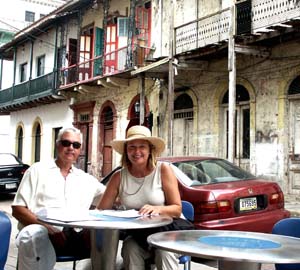 because they didn’t take credit cards) it took almost
an hour to get the change b because they didn’t take credit cards) it took almost
an hour to get the change b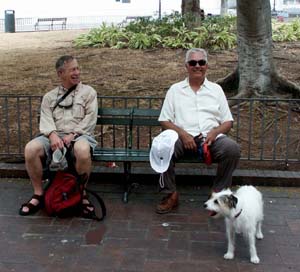 ack because they had to go to the bank to get
change. We finally gave up and Larry had them give us less money back so we
could leave. The errand guy was still not back from the bank when we left. ack because they had to go to the bank to get
change. We finally gave up and Larry had them give us less money back so we
could leave. The errand guy was still not back from the bank when we left.
We caught a local taxi and headed back to the area where
the boat was. We decided to go to the old YMCA building that used to serve the
Americans in the days of the canal, to the Internet café inside. Next to it was
a large old open-air warehouse filled with artisan vendors selling Zuna Indian
Molas and other Panamanian native crafts.
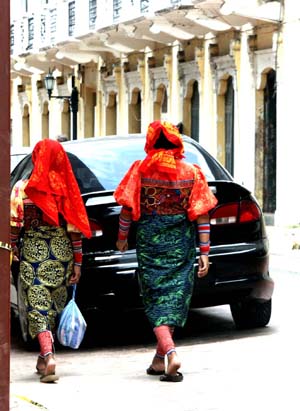
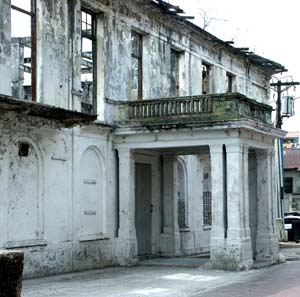
Now on to
Balboa
|